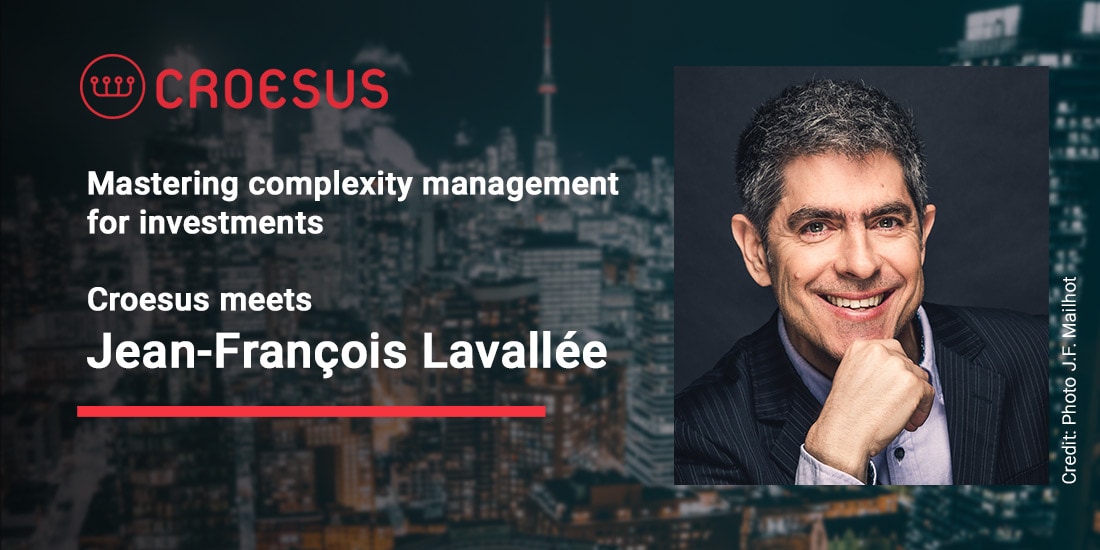
15 Feb Mastering complexity management for investments
Croesus meets Jean-François Lavallée
The work of portfolio managers is more complex than ever because of the growing number of factors influencing markets. Faced with uncertainty, financial professionals must adapt, says Jean-François Lavallée, author, speaker, and complexity management coach.
“How we advise investors must change, since portfolio management has shifted from being a complicated, thus relatively predictable environment, to a more complex environment filled with unknowns,” said Jean-François Lavallée, author, speaker, and complexity management coach.
Croesus met with him to learn how financial professionals can adapt and better meet their clients’ needs.
Croesus (C): How to define complexity?
Jean-François Lavallée (J-F.L.): Consultant and researcher David J. Snowden has defined four types of environments: simple, complicated, complex and chaotic.
In a simple environment, you’re in familiar territory with clear and identified cause and effect relationships. In this context, we have repetitive processes and we look for reliability and high-quality service.
In a complicated environment, you’re faced with problems that have a known desirable outcome. You just have to put all the pieces together and you get the result. If you put in the resources, you’re almost sure to get there.
On the other hand, in a complex environment, you know the initial conditions (the problem), but you can’t really predict their impact and you don’t know the desired result. In other words, there are a large number of possible good solutions. So you need to think about what needs to be done to manage complex situations as they arise.
The last environment is chaos. This environment usually arises when there’s a crisis. Because things happen so quickly, you can’t identify cause and effect and therefore can’t predict the outcome of your investment decision.
In everyday life and in professional settings, we’re often confronted with all of these environments. The key to success is to adopt the right approach for the right environment.
C: Why do we say that finance is a complex environment?
J-F.L.: We live in a “complex adaptive system” and finance is part of it. Increasingly, we talk about complexity in wealth management, because it is a dynamic system and there is no linear model to predict the rate of return on short-term and long-term investment. Otherwise, we would all be rich.
Globalization, instant communication, new technologies and new types of investment products, among other things, have complexified the properties of the system. All this is in addition to the human factor.
As a result, the same investment plans can’t be used like they were 10 years ago, since events that had little influence now have major consequences. For example, the war in Ukraine, which has affected world wheat and natural gas prices, has had a significant impact on Canadian farmers, which wouldn’t have been the case a few years ago.
In today’s world, you have to keep up with a myriad of topics that may or may not influence the business environment and constantly second-guess yourself.
C: What attitude should we adopt?
J-F.L.: In a simple environment where everything is known, you need to categorize to create a procedure. A complicated environment requires more analysis to make the right moves at the right time. You have to know the interdependencies and act accordingly.
In complex systems, you have to go further. You need to be curious enough to probe the unknown. Often, you have to iterate, use trial and error, to gain a better understanding of the new situation.
In chaotic circumstances, you have to act quickly to get past the crisis and think about what to do next.
C: How do we manage a complex situation?
J-F.L.: From a young age, we’re taught to look for the right answer, and that’s what’s rewarded. Those who have the right answers do well academically and later get a good job. Then, one day, you’re faced with a complex problem you don’t have the right answer to. When confronted with the unknown, the first step is to accept that you don’t have the answer.
Compared to a complicated situation, where you can set an objective because you know where you’re going, in a business complex situation, your intent must be strong because you don’t know where you’re going. For example, you may not be able to put a dollar figure on your objective, but you can aim for growth. Throughout the process, you have to stay the course.
Then, you have to be willing to explore the unknown and look for new possibilities without necessarily trying to apply old solutions to the new problem. To do this, you need a lot of trial and error and to repeat what works so you can be sure it’s not a coincidence.
The important thing is not to find the solution immediately, but to steadily move forward based on the information you’ve gathered. This means that each day, you must make the “minimum viable decision” that lets you take a step forward and then evaluate its effects. You can then decide to continue in that direction or explore another solution.
Finally, since there’s more than one right answer in this environment, there’s often a need to debate what action to take. Each stakeholder has an idea of what should be done based on their experience and expertise. To be able to move the decision-making process forward, it’s essential for everyone to demonstrate good faith and good intentions.
An ally for managing financial complexity
Financial service companies that use the automated rebalancing solution, Croesus Central, have a powerful tool to better manage the high level of complexity in today’s financial markets.
Croesus Central features a scenario analysis tool that allows financial planners and portfolio managers to test new investment strategies that match their clients’ investment policies without risking their portfolio content.

